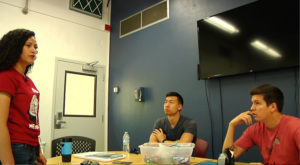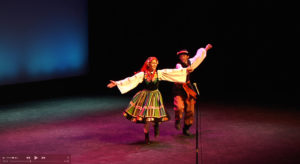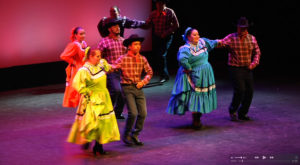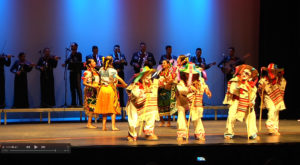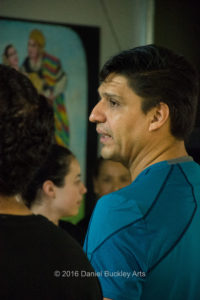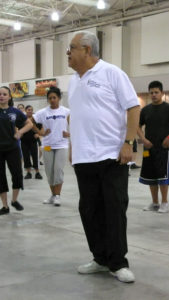If I could have a dream folklórico dance day, this past Saturday was it.
The title of this film and book project is The Mariachi Miracle. But folklórico dance is as much a part of the story as mariachi music. The two are intimately intertwined, reflecting the rhythms, traditional dress, music and dance of the various regions of Mexico that have fueled the diverse mariachi sound.
The project is about how youth mariachis and folklórico dancers have transformed the political, economic, social, educational and artistic face of Tucson. On Saturday morning I filmed an example of change in progress as mariachi and folklórico dancer Carissa Grijalva and a team of undergraduate biotech engineers at the University of Arizona worked out the kinks of their senior project – a mechanical elbow that they hope to patent.
The same skills that make her a remarkable dancer with Ballet Folklórico Tapatio were in play as they identified potential issues and solutions – teamwork, discipline, critical thinking skills, communications skills and more. It was awesome to see in action what so many former youth mariachis and dancers have described as the keys to their success in a variety of fields. On May 1 this young team of engineering students will show its finished project at the University of Arizona Student Union as part of the school’s Engineering Day presentations.
This past Saturday evening was another historic double-header. At the Berger Auditorium of the Arizona State School for the Deaf and Blind, Ballet Folklórico La Paloma was celebrating 35 years together. Founded by a group of the early folklórico program that started at Tucson high over 40 years ago, their presentation was as much a Tucson dance community celebration as a Mexican regional dance display. Along with its own presentation of choreography and costumes from various states of Mexico, the group invited members of the Fred Astaire Dance Company, the Lajokonik Polish Folk Ensemble and the Tucson Chinese Cultural Center’s Lions Dance group to share some time on the stage.
Ballet Folklórico La Paloma, which has been invited to perform at its fourth Olympics (this time in Japan in 2020), wasn’t beating folks over the heads with the connections between these seemingly dissimilar cultural expressions, but they were interwoven on a variety of different levels. On one level the fact that Tucson has come to recognize the value of dance in all of the cultures that live here together today. On another, how Poles, Chinese and many other cultures came to share communities with the indigenous people along what is now the U.S. / Mexico border, and how they intermingled and intermarried, trading elements of their homeland cultures as they did so. There would be no polkas, mazurkas, Schottisches and the like in the cultures of the Mexican border states were it not for Poles, Germans, Czechs and other European cultures who settled alongside. Likewise the accordions of Mexican norteño music and the woodwinds of the banda tradition were elements of European culture adopted by Mexicans and adapted to their own tastes.
Simultaneously to La Paloma’s anniversary showcase a few miles away at Tucson High School’s auditorium a cultural meeting of a different sort was taking place. For a number of years now Tucson’s Ballet Folklórico Tapatio has been assisting instructors from the Universidad de Colima at the Tucson International Mariachi Conference’ folklórico workshops. Friendships and collaborations have been taking place in recent years with Colima maestro Juan Carlos Gaytan Rodriguez coming to Tucson as recently as last Thanksgiving to work with Tapatio’s Grupo Oficial members, and Tapatio’s director, Jose Luis Baca.
Now, in part thanks to that relationship, Gaytan was bringing the youth he teaches in Colima – Ballet Folklórico Infantil de Colima – to present its first ever showcase in Tucson.
The talent shown at such young ages (mostly middle school aged kids) was beyond impressive. The combination of lithe precision, skillful ensemble execution, sheer athleticism and supple grace was everywhere in the dancing. It should come as no surprise, given the high pedigree of their teaching.
But in a broader sense, hosting these young dancers was a little bit of payback on Tucson’s part for all it owes to the Universidad de Colima. Many are aware that Gaytan and Maestro Rafael Zamarripa of the Universidad de Colima have been leading the folklórico workshops at the Tucson International Mariachi Conference for decades. But fewer are aware that it was Zamarripa’s old college roommate – Angel Hernandez – who did so much to ignite Tucson’s love affair with folklórico dance back in the 1970s when he was hired by Pima College to start its program.
Hernandez wasn’t Tucson’s first folklórico teacher. The art form goes back at least to the 1940s in our city. But his enthusiasm, charisma and charm, as well as his lofty artistic demands stand tall in the memories of the numerous Tucson dancers, choreographers and directors who performed with him or saw his work. And his untimely death at a young age inspired his dancers to do their best to carry on that tradition.
What The Mariachi Miracle film and book project is ultimately about is putting together the big picture of the youth mariachi and folklórico movement, from the regional cultural roots of the art forms to the living history of their being transplanted and re-seeded in Tucson, and the societal branches that grew from that solid trunk. In turn the history of Tucson’s Mexican American cultural expressions will become a point of reference by which other communities that began such programs around the country might more clearly see themselves, their accomplishments and the strengths that they have evolved from their own cultural realizations.
To witness three important and very different folklórico milestones in one day was a treat, even in a book and film project in which so many of the hundreds of interviews and performance contain revelatory kernels.
All of this is why this project has taken so long, been so involved and ultimately will be so powerful. There are still pieces of the puzzle that need to be found and put into place. We need the help of people like you to make this happen. We ask your support so that we can wrap this project up, deliver the book and film, and offer the archives created as a community resource for Tucson and America.
As we head into the 35th annual Tucson International Mariachi Conference and the avalanche of upcoming student and cultural moments in the weeks ahead, this support is critical. Please help if you can.
– Daniel Buckley, producer/director/author, The Mariachi Miracle

